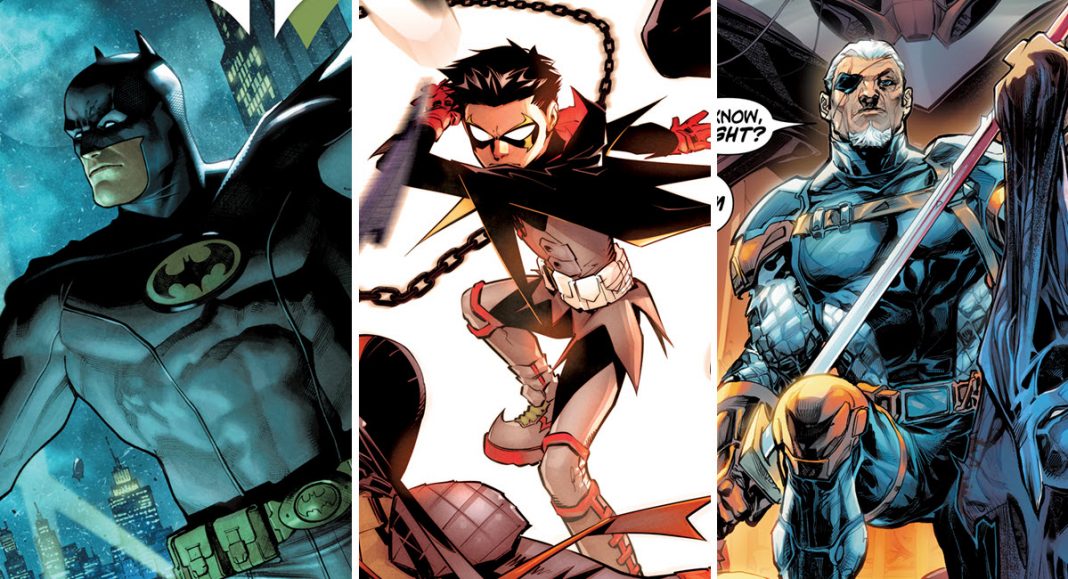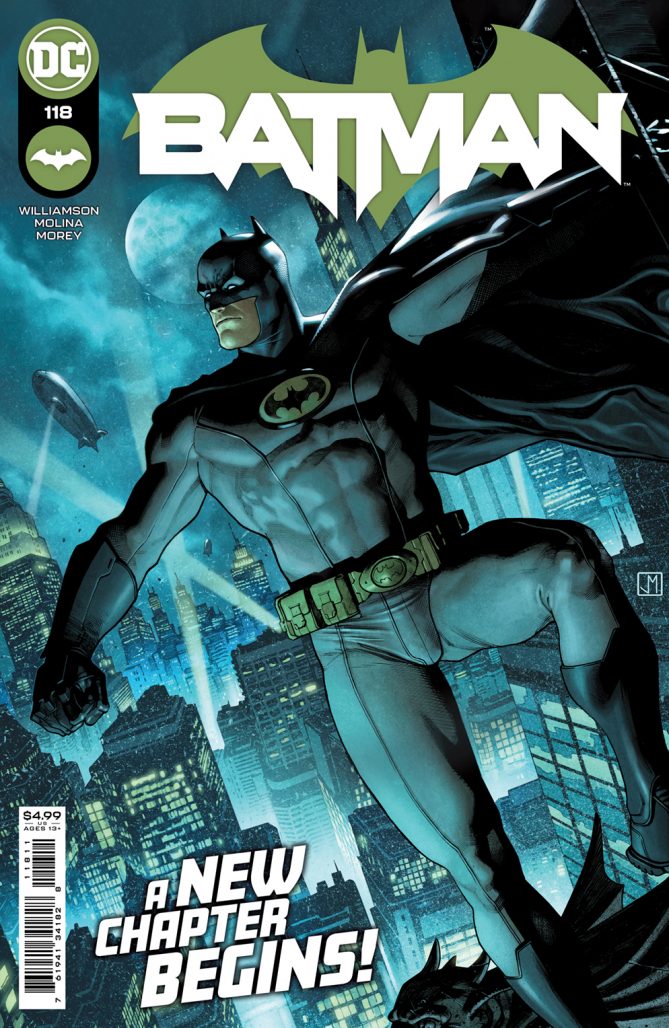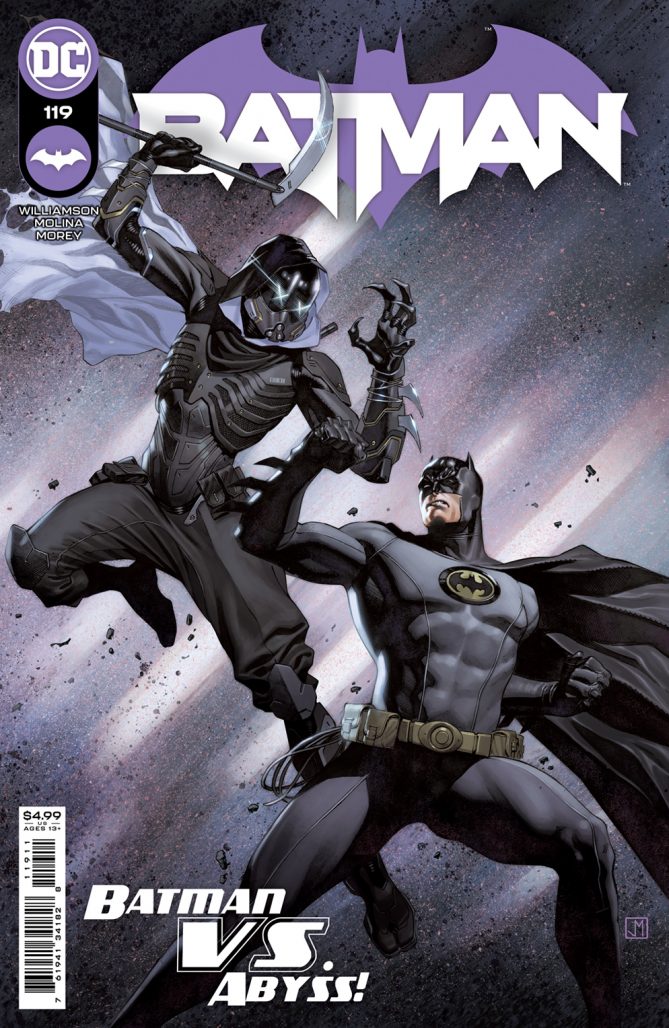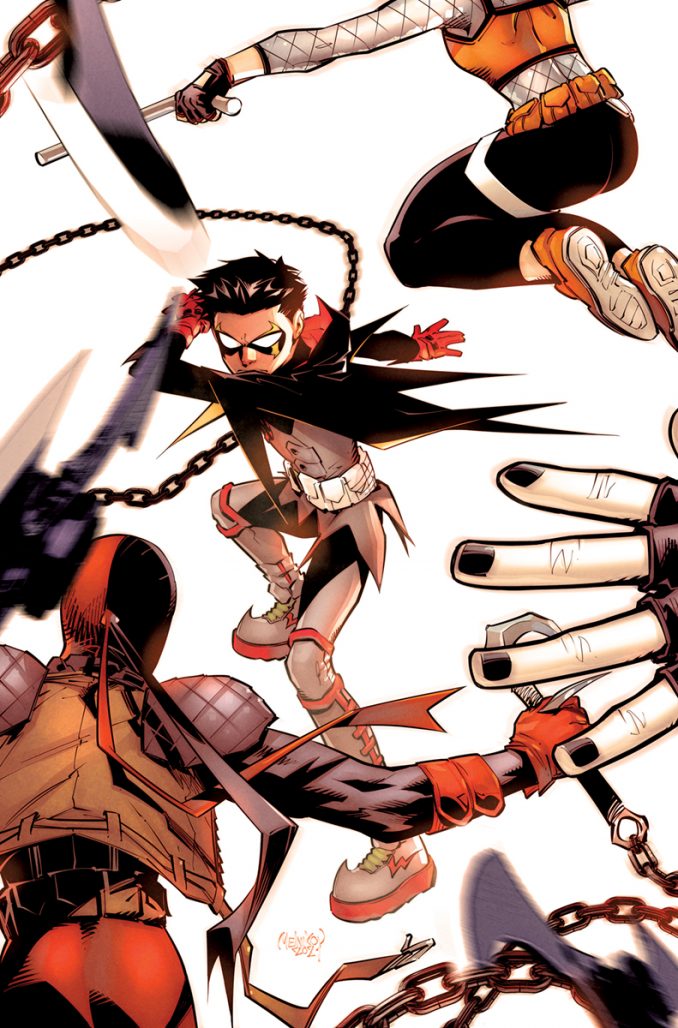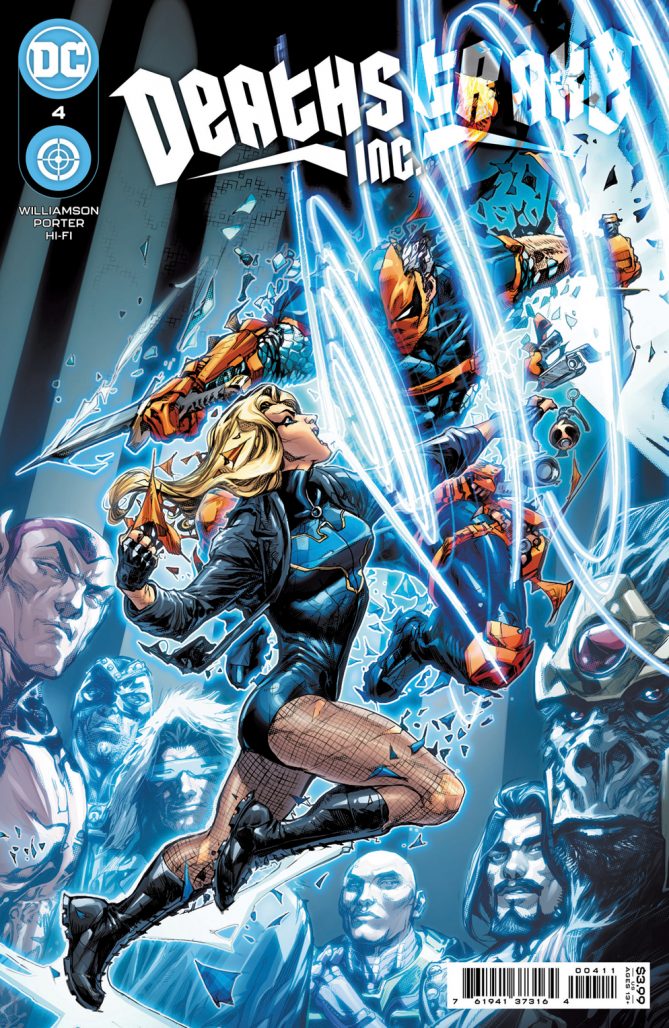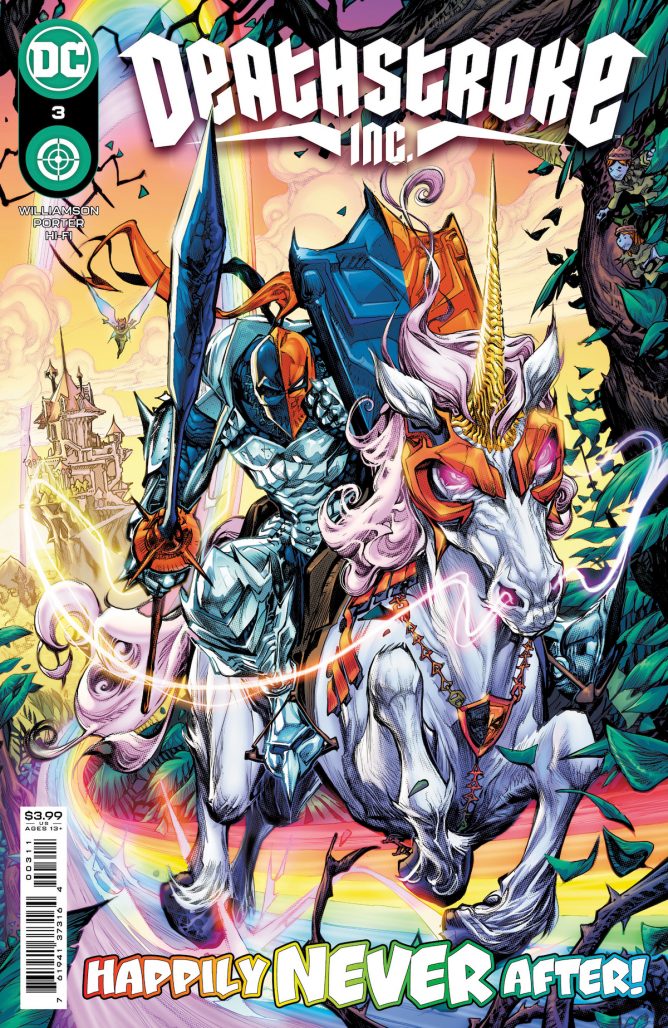Yesterday The Beat presented the first part of our in-depth interview with writer Joshua Williamson about his many DC Comics projects, from Infinite Frontier to the forthcoming Justice League Incarnate. Today we’re pleased to present the second half of that interview, in which Williamson discusses taking over writing Batman — and why he initially turned it down — where Robin is headed now that its tournament is underway, and the importance to the overall DC Universe of the new Deathstroke, Inc. series, the first issue of which arrives in stores and digitally today.
Find all that and much, much more, below.
Grunenwald: Let’s talk about Batman. The oval is back.
Joshua Williamson: Yeah, I fought for the oval.
Grunenwald: I love the oval. I was excited to see it when Dan Mora drew it.
Williamson: So I knew I was working on Batman before that issue came out, and so I was super-pumped. I was like, oh, man, the oval, let’s do the oval. It was one of the first things I asked. Because I said ‘no’ at first. Part of it was scheduling, and there’s other reasons why, but I said ‘no.’ And, you know, James [Tynion IV] is one of my best friends. I talk to him every day. I had dinner with him twice this week. So I knew he was leaving for a while, and I knew what’s going on. And so when they first offered it to me I said ‘no,’ but I kept talking about it every day, you know, and so I eventually came around to it and was like, ‘All right. Sure. I have I have a few stories in me, let’s do these stories. It worked out. It was [the] right timing because of the Infinite Frontier stuff, and some of the other things that were going on with Robin and Deathstroke and just the big picture, and it worked out.
And the oval, I was like, ‘I really want to make sure that there’s a visual difference. Can I use this oval costume?’ And so we kept going back and forth. And they were like, ‘Well, what about this, what about this?’ And I was like, ‘Well, I really want to do a mix of the Batman Inc. costume, and then a little bit of the late 1990s Batman JLA costume that was all-black with the oval.’ And so I sent designs of all of that to DC, and they went to Jorge Molina, and he basically tweaked it a little bit. So it’s pretty much the Batman Inc. costume, but it’s like tweaked a tiny bit, and that was what we we ran with was that one. But yeah, I really wanted that oval back. That was a big part of it. And it was funny because we were already doing all that stuff, and then it was like, ‘Oh, hey, Dan Mora has it in this issue.’ And I’m like, ‘Well, that’s the blue and gray costume, alright, that’s fine.’ But then, it was great, because when that came out everyone was like retweeting and excited about it, and I was like, ‘See, proof. Proof people are excited about the oval.’ And so we got the oval.
Grunenwald: It is very reminiscent of the Batman Inc. costume. And Bruce is leaving Gotham.
Williamson: Yeah, he’s leaving Gotham. After Fear State, he has a plan to leave for certain reasons. And then he’s hesitant, he has a moment where he’s hesitant to leave. And then something happens and it’s a mission he has to go on, it’s a case, and he’s like ‘I have to leave.’ And so he leaves to take care of that case. And he leaves Gotham in the hands of other people, and there’s a big story next year about that, about what’s going on in Gotham while he’s gone. But then I get to do a bunch of stories with him outside of Gotham for a bit.
Grunenwald: So he’s gonna be gone for a little while.
Williamson: A little while. Yeah, it was a really big story. The first arc I’m doing is about the first case he’s involved in, and then something really, really big happens in the DCU. Like, something bad happens, and he has to get involved. And when that thing happens, it basically brings him back into the bigger story. So yeah, something’s gonna happen, and it’s gonna be one of those things where, I don’t know how to word this…it’ll be interesting. Different people have different reactions to it, and it’s gonna cause a problem in the DCU.
Grunenwald: Okay. Is that gonna be in a book you’re writing as well?
Williamson: Yeah, yeah.
Grunenwald: It really is all connected.
Williamson: Yeah, it’ll happen in a book in March. And then, different people are gonna have different reactions to this thing happening. Some people are gonna have good reactions and some people are gonna be really, really pissed off, I mean, like in terms of characters. And Batman, that gives him a whole other case he has to deal with that puts him on a much bigger stage, and it starts to bring him into some of the stuff we’ve been doing with Infinite Frontier. And he’s trying to fix a problem.
Grunenwald: Okay. So he’s gonna be facing off against a new villain in the first arc, The Abyss. What can you tell me about them?
Williamson: Well, one of the Batman’s greatest tools is darkness, right? The ability to hide in the dark and use it as a weapon against people. And so I wanted to create a character that also knew how to use the darkness to manipulate and scare people and use it as a weapon. That’s what The Abyss is. I think people will be surprised the direction the stuff with The Abyss goes. He’s only in [issue] 118 little bit and then he’ll be in 119, 120, 121, but I think people will be surprised with the way he’s introduced. It will be kind of a surprising thing. But yeah, he uses darkness as a tool. Not like a Shadow Thief kind of way, you’ll see when we’re getting in there. It’s a different way.
Grunenwald: So you’re writing Batman, and also writing Robin. Any crossover there?
Williamson: Yeah, of course. It’ll all come together. It’s gonna be an interesting time. And Deathstroke, too. When Deathstroke #1 comes out, you’ll see that it’s all starting to [connect,] because Deathstroke connects to Robin, they’re parallel to each other. That’s why, in the Batman: Urban Legends story [starring Black Canary in issue 6], Talia was in it. It’ll be interesting, there’s so many clues in there. The thing that Deathstroke and Black Canary are dealing with is super-connected to Infinite Frontier, and there’s a clue in the Urban Legends story. And I was so surprised, no one picked it up. It’s like right there in front of you. If you Google it, you start following the Google thread, you’ll be like, ‘Oh, shit, that’s that person, there’s all these little things.’ Sometimes I’ll be talking to editorial about it and they’ll be like, ‘Oh, that’s what you’re doing?’ And I’m like, ‘Yeah, didn’t I tell you? That’s who that person really is. That’s how this connects to this, this and this.’ So the stuff that’s happening in Robin is connected with the stuff that’s happening in Deathstroke, and then those’ll connect with what’s happening in Batman, and then eventually it’ll all connect to Infinite Frontier and the big story. Yeah, it’s a lot, but it’s all connected.
Grunenwald: With the tournament, Robin is a story that feels like it has a very organic endpoint for the series basically, whenever the tournament ends. Is it going to continue beyond the tournament?
Williamson: Yeah, the story I have for the tournament, it goes to [issue] 12.
Grunenwald: I was gonna ask how long it lasts.
Williamson: Yeah, it goes to 12. I don’t want to say exactly how the tournament ends, I don’t want to give it away, [but] when the tournament ends, it’s not the end of the story. There’s more stuff that happens after that. In [issue] 6, Damien figures out who Mother Soul is, and that becomes an important part later, and then you start figuring out what’s really happening on the island, and that starts to build out, and then things kind of spin off from there.
And then the stuff that happens in Robin becomes bigger later because there’s little bits and pieces of things. The stuff with Ra’s al Ghul in issue 4, that’s actually really important for next year. To have Ra’s al Ghul living on a beach and basically saying, ‘The life I lived before wasn’t working.’ Ra’s al Ghul’s a genius, you know, he’s an immortal genius. He’s seen all these things. He’s done so much. And he is finally recognizing, ‘maybe what I was doing before wasn’t working, I need to rethink this.’ And so he told that to Damian in [issue] 4, [and] that becomes much more important toward the end of the tournament and in later issues. And then the Robin book will start connecting the bigger pieces of things after [issue] 12. But yeah, that book is gonna keep going.
Grunenwald: It’s a great book.
Williamson: Thank you. It’s a book I wanted to do for the last 10 years. I pitched it to them so many times. So then they finally gave it to me, and they leave me alone on it, so I get to just have some fun and just tell some cool Damian stories. Him on the island, the stuff with the family, the stuff with Ravager and everything, it’s all connected. The stuff with Respawn, you’ll see, it’s all gonna keep connecting.
Grunenwald: Respawn seems like– is that a character that we know who it is?
Williamson: Maybe.
Grunenwald: Have we met them before?
Williamson: Maybe. Yeah, yeah, they’ll be important next year. I will say this, you’re not gonna find out who they really are in the Robin book. You’ll find that out in another book.
Grunenwald: Interesting. Let’s talk about Deathstroke, Inc. That launches later this month. You’re introducing another sort of shadowy organization.
Williamson: Or is it an old one renamed?
Grunenwald: Or is it an old one? I don’t know, that’s my question!
Williamson: I mean, they’re called T.R.U.S.T. I mean, come on.
Grunenwald: Is there any crossover with what’s going on with Checkmate and Leviathan and all that stuff?
Williamson: Yeah, all that stuff will come into play together at some point. I’ve read the last two [issues] of Checkmate, because Damian and Talia are in there. So the stuff that’s happening in there, we’ll eventually reflect it in both Robin and Deathstroke. At the end of Checkmate, we will line up. I talked to Brian Bendis about it a few weeks ago, because he and I would compare notes. We had two calls. Two days in a row, long calls about everything we were working on, just to make sure. I was telling him what’s going on with Black Canary so we could all match everything up.
Grunenwald: Yeah, I was gonna ask about Dinah.
Williamson: Yeah. The Deathstroke book, sometimes I wish we had called it Deathstroke & Black Canary, because she becomes more and more important as the story goes on. The story is, Deathstroke has walked in the middle, or tried to walk in the middle, for a long time. And every time he tries to be good, or he tries to keep walking in the middle, and it doesn’t work, and I think at some point, he’s going to realize, ‘Oh, I’m a bad person, and I’ve done bad things.’ And it’s like, maybe this is his lot in life, his lot in life is to be a bad person. And so this book is him kind of realizing that, and then being like, ‘Okay, what do we do with that idea?’ And then Black Canary is there, and Black Canary is like, ‘Don’t. Maybe you just stop.’ Like, there’s a there’s a scene in issue 6 where she’s like, ‘Just stop. Maybe just take the mask off, put the sword down, and go hug your family, and just don’t be this thing.’ And he’s just like, ‘Nah. Nah.’ [And] he becomes more and more important in the DCU as it goes.
This book is gonna be a little bit slow burn. [Issues] 1 and 2 are standalone stories, and then 3 starts to kick it up. [Issue] 3 is the first time we have a real cliffhanger. And then 3, 4, 5, and 6 are all like one long thing. They all just, especially for 5 and 6, they’re really just like, ‘boom, boom, boom, boom, boom,’ they’re right after each other. They’re very much like, not one scene, but it’s very much a sequence of events that probably take place in like an hour. Because — getting really into spoilers here — once Black Canary and Deathstroke figure out what’s actually going on, because they’re both trying to figure it out, so once they both figure it out, then shit hits the fan. Then it’s like, ‘Okay, what do we do with this information now that we know what’s coming?’ Once they figure out what T.R.U.S.T. actually is, they’re just like, ‘Oh, this is a bad.’ But then it just escalates. And then there’s the moment where basically Black Canary is like, ‘You should just stop this,’ and Slade’s like, ‘No, no, I’m gonna keep going on this path that I’m on.’ So it’s gonna be an interesting book.
The Deathstroke book is really important for next year. And part of it is, it’s about getting these pieces on the table. Like a lot of things are about, we’ve got to get these people in certain places, and certain story pieces where we need them, so that next year, when we have some of the bigger stories we’re doing, those pieces are where we need them to be. And that’s part of what Deathstroke is. I needed certain pieces to be in certain places, but I didn’t want to just say, ‘Oh, this happened.’ I wanna show how we got here. So it’ll be one of those things where next year, there’s gonna be some really big things that happen in the DCU next year, and it’s like, ‘when the fuck did that happen? How did this person get here?’ And it’s like, ‘well, actually, there’s a little book over here about this. There’s a whole book that explains it.’
It’s interesting with Deathstroke because at one point I just gave up on the covers, because I was trying to keep it secret. And then I was like, ‘You know, whatever. I just put it on the cover.’ So as the covers go, I think I think the cover to issue 4 is Black Canary and Deathstroke fighting, because they figure out what’s going on and they fight about what to do about it. Then the covers the 5 and 6 basically give it all away. [Issue] 6 is like, this is what’s going to be coming is this,’ but you’ll, you’ll see. It’s a very different book. It’s a very slow burn kind of weird book, and I think in the first few issues it’s a bit more on the fun side. But once you get to the end of [issue] 3, then it is just like, boom. It’s all about getting this stuff where it needs to go.
Grunenwald: Gotcha. You’ve talked about how Deathstroke is leaning into or coming to terms with the fact that he is a bad person, because he is a despicable person who has done terrible things. Is that a challenge at all to write that character as the lead of the series, and still have there be something that readers can relate to or grasp onto with that character’s journey?
Williamson: I think with this book, it was better that I have Black Canary around, because Black Canary is great, and she has a very strong moral compass. And it becomes important to the story, the idea that they they balance each other out, because as bad as he is is as good as she is, right? That’s a part of the story. There’s a reason T.R.U.S.T. wanted both of them. And so with him, writing a character who’s a bad person like he is and coming to that realization of it is tough, because I don’t want to redeem him. It’s not a story of redemption. So I never wanted you to root for him. I don’t want the reader to root for him. I want you to maybe like see the– it’s hard to explain, like when I was running Nailbiter, Warren in Nailbiter is a bad person. He’s a serial killer and he killed lots of people. But I would find constantly it would be like, ‘Oh, he’s so funny.’ And it’s like, ‘Oh, this is why Ted Bundy got away with it,’ you know?
Grunenwald: [Laughs] He’s very charming.
Williamson: Yeah. And I think there are times with Deathstroke where I needle that a little bit, where it’s like, ‘Oh, he’s fun, because he blew something up, or he comes in with a gun and shoots a bunch of stuff in here.’ It’s that idea of what people find appealing of those kinds of characters, so I play with those ideas, but then I try to find places to remind you, he’s still a bad person. I mean, maybe it’s because Black Canary and him are talking about it in every issue, but there’s something to him that’s interesting. And there’s moments, actually in issue 2, I think there’s moments where he does like, a good thing. I think I think in [issue] 3 there’s a scene with Cheetah, they try to find Cheetah, they find her and she realizes what’s going on. She’s basically like, ‘Wait, you’re working for T.R.U.S.T.? Do you know what T.R.U.S.T. really is?’ And he’s like, ‘What is it?’ But then she starts to basically be like, oh, okay, and she kind of rips into Slade like, ‘Who are you pretending to be right now?’
What happens is, is that an issue 3, they find out that The Queen of Fables will basically give people safe houses. So you can write your own fable, and she will put you in it, so you can stay there for a bit as like a safe house, a way to get away. Cheetah’s in one, and that’s why, on the cover, Deathstroke’s riding a unicorn in a knight’s armor, because she’s basically created a fantasy land to hide in, and so he has to go into it to get her. The whole thing is that she’s trying to escape reality by going to this fantasy world, and she’s like, ‘we get you like playing hero. You’re just doing the same thing. This is a fantasy. You’re not this person, playing a hero and pretending to be this like, it’s no different from what I’m doing. You’re escaping who you are.’ And she basically confronts him with all those ideas. And that’s part of why when [issue] 3 hits, the end of 3, that’s when everything starts to like rile up and build from there.
Grunenwald: Man, The Queen of Fables. I did not expect to hear that character’s name come out of your mouth. Between that and Robin with — I mean, Connor Hawke, obviously —
Williamson: Well, I love you Connor.
Grunenwald: Connor’s great, but you’ve got other, like, obscure Nightwing villains. It feels like you’re celebrating everything.
Williamson: I have holes, but I do feel like every comic post-Crisis, if it’s a DC book, I’ve probably read. There’s definitely moments where I’ll talk to somebody and I’m like, ‘Oh, I don’t remember that one.’ And once you get like, Yeah, I would say from like, post-Crisis to about 2010 —
Grunenwald: The New 52?
Williamson: — I’ve probably read all of them. Well, yeah, that’s part of it, and then going into 2011, life changes, things change, and so I wasn’t able to afford to buy the same amount of books or do some stuff I was doing. And then when I got to The New 52, I was buying certain books. I was still buying Batman, you know, I was still buying Flash, I was still getting Justice League, but I wasn’t getting everything. I’d get bits and pieces, and I’d kind of read here and there. So there’s times where I have like little gaps, you know, but for the most part. I was having this conversation with Ram [V], Ram and I were talking about Justice League Dark when he was gearing up to do the backups, and he was like, ‘Well, I’m gonna bring an obscure character into this.’ And I was like, ‘who,’ he’s like ‘Ragman,’ and I was like ‘Ram, come on, man. That’s not obscure,’ and he’s like, What, Ragman is obscure,’ and I was like, ‘Not to me. To me that’s not obscure. There’s all kinds of obscure characters. Bring me a Bloodlines character and then talk to me about obscure.’
But yeah, you know, I know DC history really well. That’s why I was some of the stuff, even in Infinite Frontier or any of these things, it’s like, I just know it. I just know those characters. I know the world. I know so much stuff. I get things wrong sometimes. Like, there are times where I’ll have stuff and I’m like, ‘Oh, yeah, I forgot about that.’ Or, and I have to be careful about this, there are certain things that are like my own headcanon that aren’t real, and I have to be like, ‘Okay, wait a minute, that’s what I thought happened, it may not be what happened.’
I’ll give you an example. So in Robin #5, there’s a part where Tim Drake says Damian slit his throat. And after it came out, it’d already went to the printer, the editor actually was like, ‘Hey, when did that happen?’ I’m like, ‘That happened in Batman.’ And he’s like, ‘I don’t remember when that happened.’ [So] I went back and looked, and what happened was, Damian punches Tim, with like, brass knuckles that have spikes on them, and then in the next issue Alfred is like, ‘Tim lost a lot of blood. I barely got him in time.’ In the shot, it looks like he got his face or his neck, so in my brain, I was always like, ‘Oh, he must’ve cut his neck.’ It’s not there, but in my brain he did. It’s stuff where I have to remind myself every once in a while to double-check something. So I’m always doing research. I’m always going and reading books, I have a billion books in my office, I just grab stuff. Anything I’m working on, I usually have that reference stuff right behind me, so I [can] flip through and I go, ‘Okay, this is exactly what happened.’ Or I got it right.
So every once in a while, I’ll get it wrong, but I’m lucky because there’s a couple editors at DC that are very knowledgeable as well, you know. And so they’ll they’ll, they’ll be like, ‘Hey, I saw what happened,’ and like we talked about I go back and look. But I know the history of DC, especially post-Crisis. It’s interesting because there’s other people I know who know before a lot more. But because I’m much more of a like ’90s DC fan. I would say like, you get around to Death of Superman, get around to that where all those changes were happening with Superman, and Tim [Drake]’s around, and Bart [Allen], Connor [Kent]. You get all the way to about Infinite Crisis, that’s probably my favorite era in that whole section there. That’s what I really loved.
I was doing a lot of research on One Year Later recently, actually, just looking at some of the stuff that happened in those books. I was looking at Infinite Crisis a lot, just checking a couple things with it, especially when working on Infinite frontier and wanting to make sure I had some of the Alexander Luthor stuff right. Because with Pariah at the ending [of Infinite Frontier #6], I wanted to make sure I had it correct. And looking at that book, a lot, and Final Crisis, and the original Crisis, a lot of stuff. My head is very in that world right now.
Grunenwald: I reread The Multiversity recently, because I had to look up who The Empty Hand was. And I was like, ‘I don’t remember anything about that character.’ So I read it, and I had forgotten that that’s basically just the origin of Justice Incarnate. So you’re really getting to do the first book with that team.
Williamson: No one picked it up!
Grunenwald: Yeah, it’s crazy.
Williamson: No one picked it up. I was actually thinking about, I need to email Grant [Morrison]. I have a bunch of questions. Dennis Culver is a huge Grant Morrison fan. I love Grant’s work. I met Grant many times. They are a very intimidating person for me, because I love their work so much. But I’m not as obsessed with Grant’s work as Dennis is, and Dennis definitely will catch me on stuff. I’ll be thinking about something, I’ll be writing something about Multiversity stuff, particularly Multiversity or all the more like bigger ideas of it, and sometimes I’ll stumble into stuff. I’ll stumble into something and be like, ‘I’m gonna do this.’ And then I’ll go and I’ll look at Multiversity and be like, ‘Grant already put these pieces on the table!”
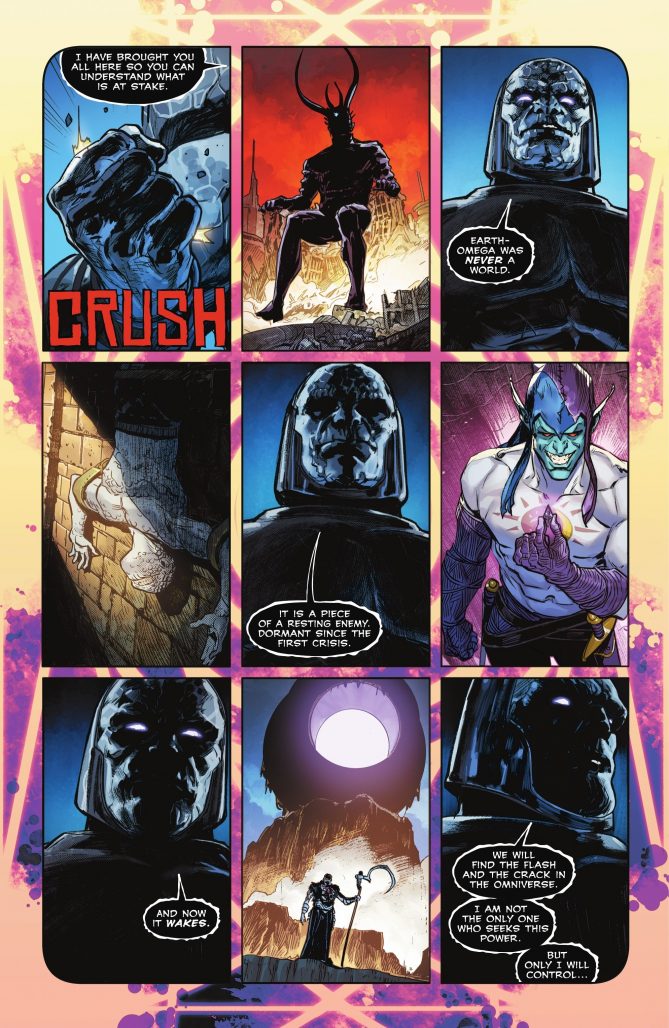
I think the thing that Grant does, it’s really interesting, is that Grant looks at comics almost as historical text. And you go through everything, interpret things differently and do things differently. You can discover some things and you can add to it, and then somebody else can come down the line later and look at it and go, ‘Well they meant this, or they could’ve meant this.’ And that’s what I’ve done with a few things where there’s things that have been, even before Multiversity, things from Crisis, things that Alan Moore was working on or stuff that was even before that, some of the Jack Kirby stuff. And it’s like, ‘Oh, it’s interesting, all these little pieces are here. But what if they don’t mean that? What if they mean this over here? What if that logo isn’t the logo we think it is? What if we turn it on its side a little bit, does it mean something else?’ So it’s like a lot of things like that. There’s there’s a lot of stuff like that in Multiversity, like that guidebook. And there’s a lot of clues and things that will come down the line throughout Multiversity, of stuff we have planned with The Empty Hand, what Multiverse-2 is, all that stuff will come around. But yeah, you almost have to read Multiversity to understand everything that we’re doing.
The first issue of Williamson and artist Jorge Molina’s Batman run arrives in December. Deathstroke, Inc. #1 is in stores now.


